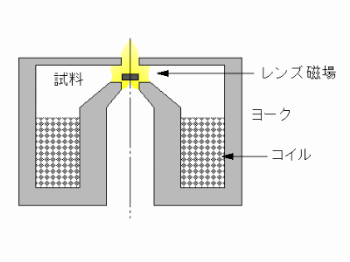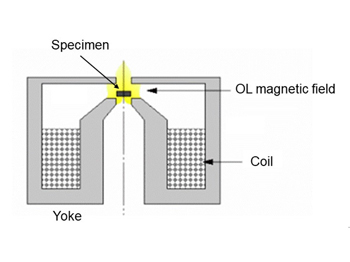インレンズ形対物レンズ
インレンズ形対物レンズ
in-lens objective lens
[目次:装置]
高分解能SEM用の対物レンズの一種。
このレンズは非常に焦点の短いレンズで、広く使われているアウトレンズ型対物レンズに比べて、球面収差と色収差が1/10以下になる。そのため、高加速電圧のみならず低加速電圧でも、SEM像の分解能が大幅に向上する。図に示すように、試料は対物レンズのポールピースによって作られる強い磁場(黄色部)の中に置かれる。 ただし、試料周辺の空間は狭く、扱える試料の大きさは数mm径で高さは2~3mmである。磁性体試料はレンズの強い磁場によって磁化されるので、磁性体の観察には適さない。EDS検出器の装着は可能であるが、WDSやEBSDなどの検出器を装着することはできない。二次電子の検出には、TTL検出器が用いられる。試料ステージには、サイドエントリータイプのゴニオメータステージが使われている。レンズの構造ならびにゴニオメーターのタイプもTEM仕様のものと類似している。

図 インレンズ形対物レンズ
One of the objective lenses for the high-resolution SEM.
The in-lens objective lens has a very short focal length, and both spherical and chromatic aberrations of this lens is one to tenth or less compared to those of the out-lens objective lens. Thus, the SEM image resolution is greatly improved at high-to-low accelerating voltage. As shown in Figure, a specimen is placed in a strong magnetic field (indicated by yellow region) created by the pole-piece of the objective lens.
However, the space around the specimen is narrow and the size of the specimen which can be handled is limited, several mm in diameter and 2 to 3 mm in height.
A magnetic material (magnetic specimen) is magnetized by the strong magnetic field in this lens, thereby not suitable for observation of the magnetic specimen.
For the SEM instrument equipped with the in-lens objective lens, it is possible to attach an EDS detector, but WDS and EBSD detectors cannot be attached. To detect secondary electrons emitted from the specimen, the TTL (through-the-lens) detector is used. The side-entry goniometer stage is used as the specimen stage. Due to the structure of the in-lens objective lens, the type of the goniometer stage is similar to that for TEM.

Fig. Schematic of the in-lens objective lens
関連用語から探す
説明に「インレンズ形対物レンズ」が含まれている用語






